
ChatGPT was developed by OpenAI and was released on November 30, 2022. In just two months, it became popular worldwide, with over 100 million monthly active users. ChatGPT can engage in conversation and communication by learning and understanding human language, achieving true artificial intelligence.It has aroused extensive attention on AI in human history.(Note: The release of the new model ChatGPT-4 on March 14th, 2023 has once again amazed people.)The hotly discussed about ChatGPT in various fields are:what works can ChatGPT do in a particular field and which work will be replaced? As intellectual property industry practitioners, we believe that ChatGPT supports strong capabilities in underlying architecture, models, algorithms, and data, which have high adaptability to the current work requirements of intellectual property. From a short-term perspective, ChatGPT is bound to replace those jobs in the field of intellectual property where communication and creativity are less relied upon, and will have a profound impact on the jobs that are survived. From a long-term perspective, as ChatGPT's intellectual and thinking abilities continue to grow, it may enter a stage of strong artificial intelligence with strong thinking, logical abilities, and creativity.
Functions of ChatGPT
1. More than just a chat tool
For many novice users, they may assume that Chat GPT is just a simple chat tool when they only find a simple question input box after log into ChatGPT. ChatGPT is a conversational AI based on the GPT-3 language model (the word "Chat" in its name). It can learn the grammar, semantics, and logic of natural language and provide answers by understanding the questions it received .ChatGPT not only provides a "chatting" function, its "chatting" function essentially reflects its powerful ability to complete tasks based on instructions. With its powerful algorithm model and massive training data, ChatGPT can help us do many things.

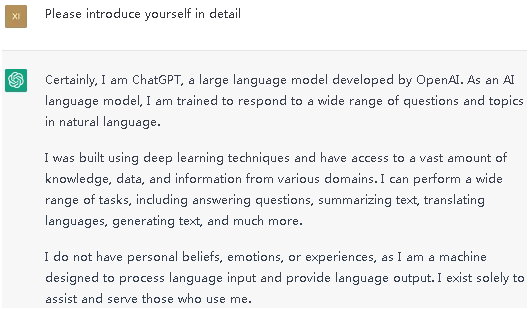
2. Answering technical and legal questions related to intellectual property (IP)
The full name of "GPT" in ChatGPT is Generative Pre-trained Transformer, which is a deep neural network pre-trained on massive data. The model can master the general natural language processing abilityduring the repeated learning process,. According to public information, the text used for pre-training the GPT-3 model has reached 45TB(more for newest GPT-4 model)including a large amount of natural language text such as books, articles, news reports, social media posts, etc.
The full name of GPT in ChatGPT is Generative pre-trained Transformer, based on the Transformer architecture. It is a deep neural network pre-trained with massive data, and in the process of repeated learning, the model can master universal natural language processing abilities. According to public information, the GPT-3 model used 45T of pre-training text and became a large language model (LLM). (The latest GPT-4 model used even more pre-training text). This includes a large amount of natural language text, such as books, articles, news reports, social media posts, and so on. Through repeated learning, ChatGPT can provide accurate and comprehensive answers to various technical, legal, and other questions that intellectual property professionals may be concerned about.
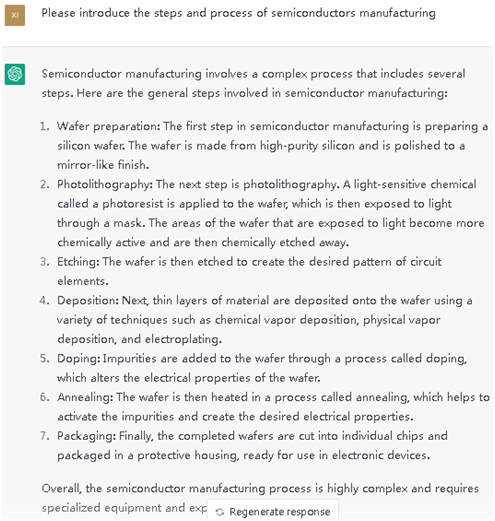
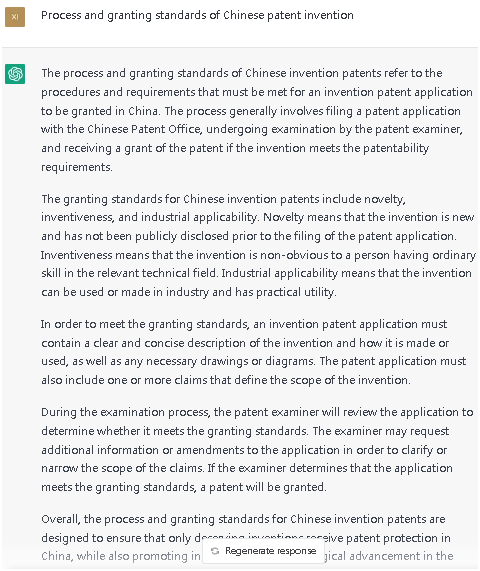
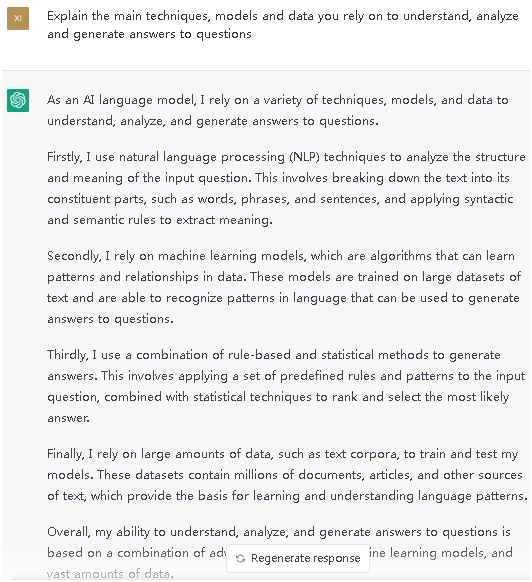
3. Producing and creating content
Unlike traditional chatbots, ChatGPT is a "generative" language model, which is a type of AGI (Artificial General Intelligence). The ChatGPT model is a large language model that generates content using the "auto-regressive generation" method, that is, by predicting the most likely subsequent vocabulary based on the input text. During the training process, it learns to generate coherent and relevant text by imitating the text structure and language patterns in the training data. ChatGPT is not an enhanced version of a search engine that relies on ultra-high computing speed to find content that is close to the input. Instead, the model generates content based on the knowledge it has learned from the training data.
Due to the 175 billion parameters and deep training of OpenAI's GPT-3 model and astonishing 1 trillion parametersof GPT-4 model, it can create various types of content, such as promotional materials, legal documents, and even help write a paper or a long report based on simple instructions. It is difficult to distinguish between text generated by the model and human-written articles.

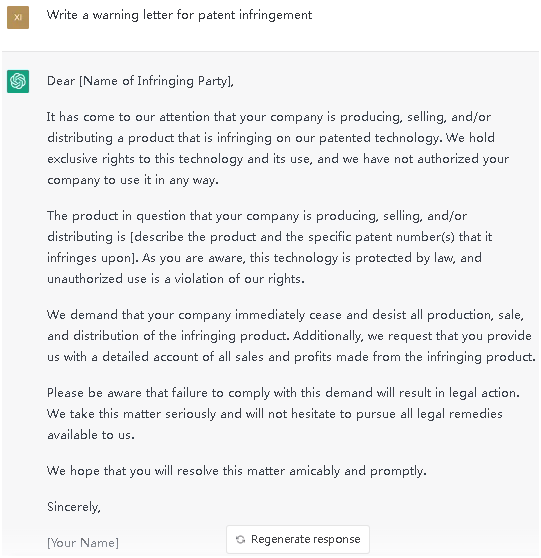
4. Understanding, summarizing, and generalizing
The GPT model is a natural language processing model that recognizes and understands complex language structures during the learning process.ChatGPTacquires the ability to summarize by deep learning algorithms and natural language processing techniques, comparing two documents is a trivial task for it. For example, when given a patent technology proposal as input, ChatGPT can quickly summarize the key technical points of the patent (Due to the insufficient amount of training data for patent information, entering only a patent number may result in obtaining incorrect patent information.). The ability to summarize is an important skill for intellectual property practitioners, for example, when drafting claims, and reporting the Office Actions.
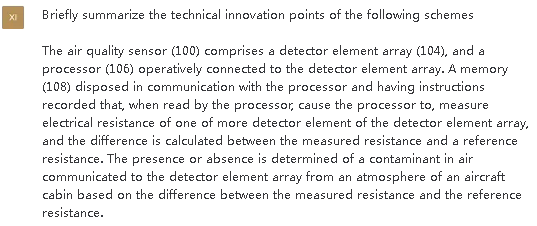
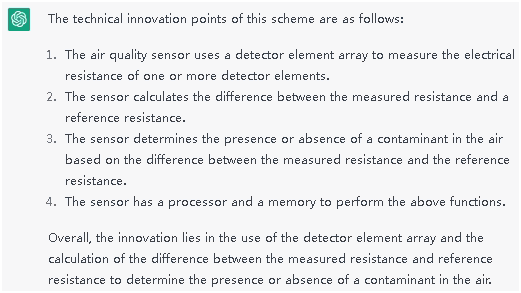
5. Prediction
ChatGPT is based on machine learning and natural language processing technologies. It forecasts future developments including technology and industry trends based on past data and trends, such as time series analysis, text classification, and clustering can be used to forecast future developments, and so on.
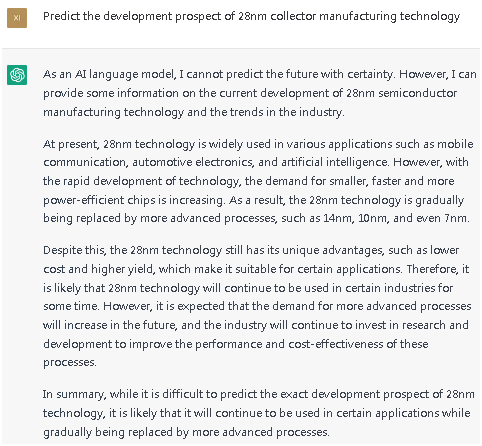
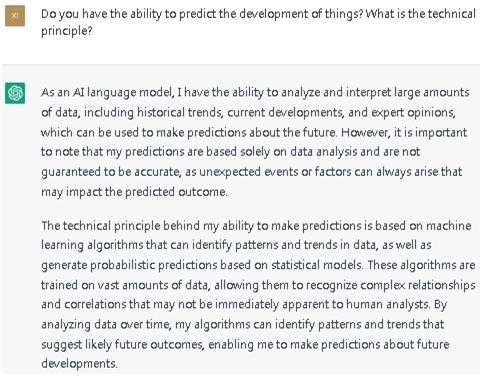
6. Continuous interactive communication
Unlike other chatbots like Siri, ChatGPT is not a pre-programmed response system. It can remember past conversations and make continuous responses based on those previous interactions. In other words, we can communicate and interact with ChatGPT repeatedly for a specific question, obtaining multiple answers from different perspectives or obtaining a more specific answer to a particular detail. Itresembles the situation of makingdesign-around or responding to Office Action.
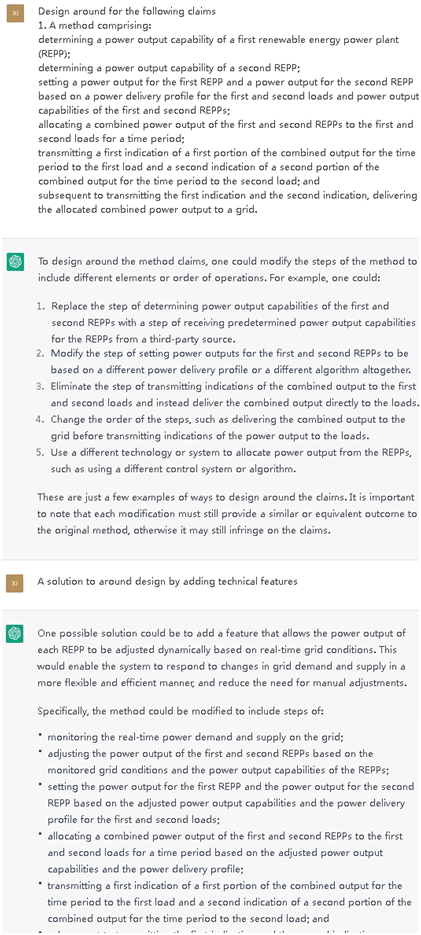
7. Integration with Software Tools
ChatGPT can be integrated with existing software tools, such as search engines, video conferencing software, document editing software, AI drawing software, and others, and produce surprising results.ChatGPTenables the software tools to AI capabilities through installing plugins and programms. For example, Microsoft's latest version of Bing search engine with ChatGPT integrates search results in a conversational way, displaying analyzed and aggregated information, and providing information sources (it precisely makes up for the shortcoming of ChatGPTwhich can't provide source links to users, currently, the web GPT also is newly developed to show the information sources.). Bing is already a competitor to Google, and it will bring revolutionary changes to search engines with its integration of ChatGPT. For example, it can directly generate comparative analysis results of the financial statements of two companies, such as BYD and Tesla.
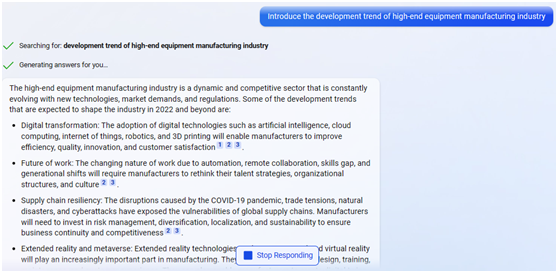

Microsoft has also integrated ChatGPT with its video conferencing tool Teams, enabling real-time translation of meeting content, as well as completing administrative tasks such as drafting work emails, taking notes, and creating meeting minutes.
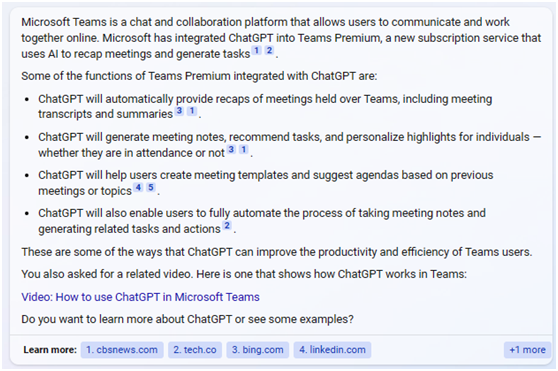
At the same time, on April 16, 2023, Microsoft officially incorporated OpenAI's GPT-4 into its office software, Office, and launched a new AI feature called Copilot. This has redefined the workplace value of many skills and disrupted existing office practices. In Word, Copilot can assist in editing, summarizing, and creating documents. In PowerPoint, it can generate a presentation with just a sentence, and in Excel, it can directly generate analysis charts and process data.
8. Processing ability is not limited to text only
The previous examples only highlighted the text-based capabilities of ChatGPT, but there are now many applications of ChatGPT in audio and video production. ChatGPT can generate code or scripts, which can then be used to create corresponding images and videoswith professional software tools (such as CAD, Midjourney, Synthesia, Veed.io).Compared to ChatGPT 3.5, the latest ChatGPT 4 further possesses multimodal processing capabilities and can edit and generate images (this feature is yet to be made available to the public).
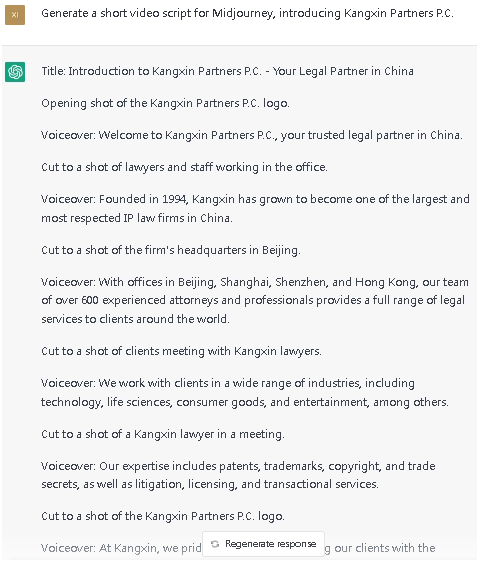
The large language models of ChatGPT continue to exhibit abilities that even their developers could not predict. For example, after the development of ChatGPT-4, developers are constantly learning and becoming familiar with the various unexpected abilities it exhibits.
Applications of ChatGPT in the field of intellectual property (IP)
Artificial intelligence tools represented by ChatGPT have shown powerful capabilities.With continuous accumulation of self-training and integration with other software tools, the product functions of ChatGPT, as a representative of AI tools, will continue to evolve and its ability to handle actual work will become increasingly mature. It is foreseeable that artificial intelligence tools such as ChatGPT will inevitably enter the field of commercial application in the future. With the regulation of relevant legal and ethical issues, new business models will emerge, and there will be unprecedented impact on some professions and positions.
9. Overview of ChatGPT Applications in Intellectual Property Industry
Based on the basic capabilities of ChatGPT and the current application tests, from a technical perspective, ChatGPT can assist us in handling the following types of work:
Text writing and editing, such as writing application documents, business letters, and translating.
Text analysis, such as technical documents, research reports and comparative analysis
Data statistics and analysis, such as the statistics and comparison of patent data and financial data.
Information acquisition and integration, such as collecting and initially organizing various types of information on law, technology, economy, and industrial development.
The application forms of ChatGPT will also become more diversified with the deeping of practice, such as access to official websites, WeChat groups, office systems, professional tool software, and so on. It can be imagined that in the future work scenarios, software tools with AI attributes may appear in any area where artificial intelligence can play a role.
Application Area 1: Secretarial Tasks
The secretary position involvesadministrative and process-oriented tasks such as letter writing, files receiving and sending, formatting and processing, as well as work documents generating such as meeting minutes and statistical reports, translating documents, and so on. These tasks required low creativity and need to repeat process. ChatGPT's involvement in this field is quite extensive.ChatGPT's content generation function will replace these repetitive content-related tasks. In the future, ChatGPT will further improve the intelligence of process managementthrough integration with office systems.
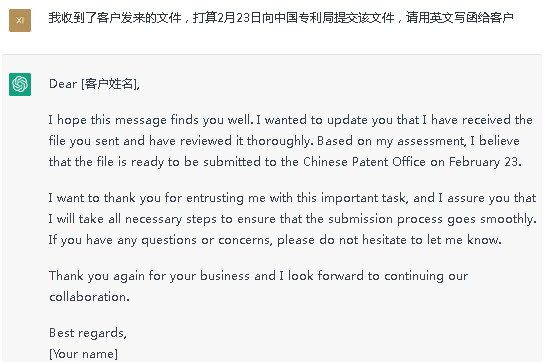
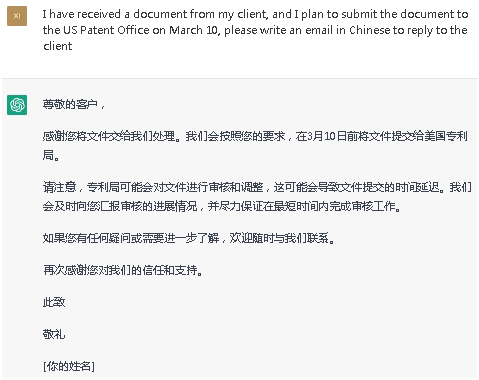
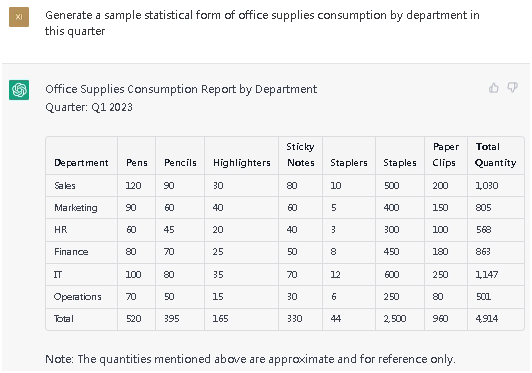
Application Field 2: Customer Service
Customer service positions are mainly responsible for answering customer inquiries and providing feedback of related work processes. ChatGPT is precisely an expert in answering questions. Currently, some banks and e-commerce platforms have introduced robot customer service. In the future, the intellectual property service industry can rely on AI chatbots such as ChatGPT to provide professional answers to customers (as seen in the previous example), and gradually form their own characteristics and advantages through professional knowledge training. At the same time, it can also be integrated with case management systems to provide clients with progress queries and explanations for patent application and examination (internal process management system matters are not recommended to be introduced for confidentiality reasons).
Application Field 3: Brand Promotion
The brand-related positions are mainly responsible for promoting the company's brand, culture, and image. ChatGPT can utilize its powerful content generation ability to produce relevant copywriting, videos, and more (as seen in the aforementioned copywriting and video examples).
Application Field 4: Intellectual Property Litigation Attorneys
The jobs of litigation attorneys rely heavily on communication and collaboration which requires confidentiality. ChatGPT may not be able to replace the core work of lawyer jobs in the short term, but it will play an important role in assisting attorneys' work. ChatGPT can assist in generating simple legal documents such as patent infringement warning letters (as shown in the previous example), generate legal document samples based on the legal regulations of different jurisdiction, and generate more complex documents. It can also provide answers to related legal questions. In addition, in patent litigation, ChatGPT can also help us find evidence of infringement (such as sales data) and patent invalidation(at present the results may only be non-patent document).
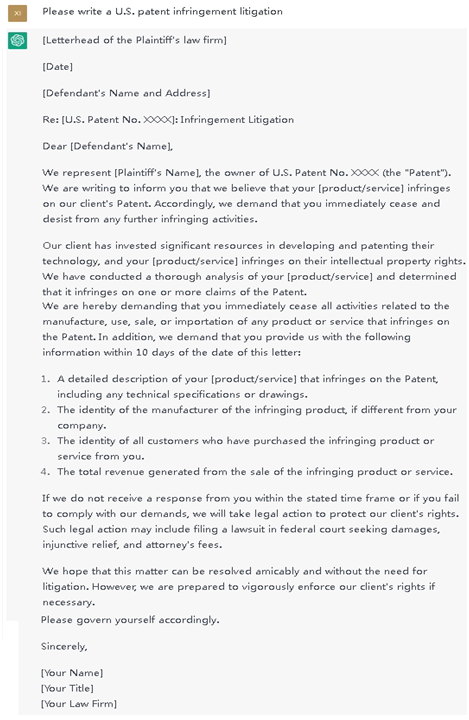

Application Field 5: Patent Attorney
Drafting patent application documents and responding to Office Action are the main tasks of patent attorneys. Although summarizing and answering questions are the core abilities of ChatGPT, it is difficult for ChatGPT to replace the core work of patent attorney due to confidentiality and communication with inventors. However, it will play an important role in assisting patent attorney. ChatGPT can help patent attorney understand technical solutions and prior arts, and provide ideas for application document drafting and responding to examination opinions.
The reply to the examination opinion will be the first scenario where ChatGPT will be applied. ChatGPT can summarize examination opinions and notices, translate them, and generate corresponding reference response texts based on the examination opinions and notices. Due to confidentiality restrictions, it is not feasible to use ChatGPT to directly draft patent application documents, but ChatGPT can assist in generating patent claims templates. (The following example uses the specification of a published invention as an example).
Reply to Office Action
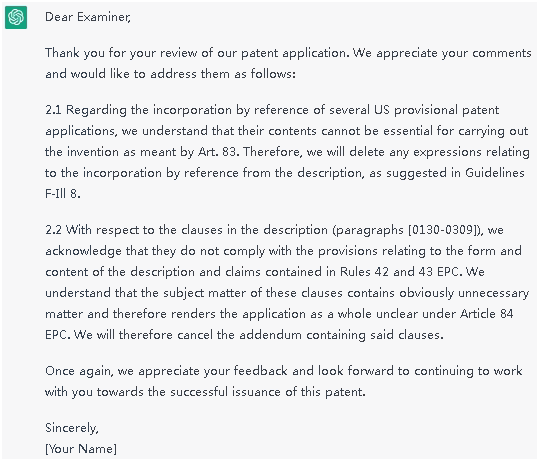

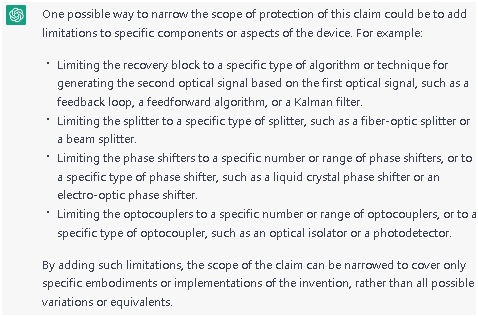
Drafting of Claims
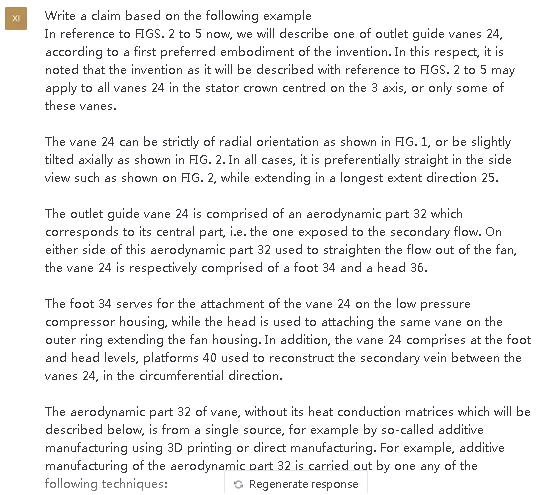

The following is the actual patent claims drafted by a patent attorney:

ChatGPT can also play an important role in guiding innovative concept of technicians.
Application Field 6: Intellectual Property Consultant
Consultants are required to provide consulting advice on technology developments basing on patent information, generate proposal in IP strategy and patent layout, determine patent infringement risks, give advice in intellectual property management, etc. for clients from different industries. ChatGPT can help consultants quickly understand the basic situation of a technology field or industry and basic situation of entrusting party and their competitors. At the same time, based on the integration and sorting of existing information, ChatGPT can use techniques such as model training, time series, and text clustering to predict future development prospects and directions, providing analysis and ideas for consultants. It can also provide inspiration for risk avoidance design (as shown in the previous avoidance design example) and invalid evidence in some on-patent prior art. In addition, it can assist in keyword expansion and technology construction when retrieval of patent data. Currently, as ChatGPT has not yet be trained by data from patent database, it is not yet possible to obtain patent data by inputting the name of applicant or keywords related to the technology field, as what the patent database has done. Therefore, ChatGPTcan't replace part of work in the patent retrieval , patent portfolio analysis work currently .
Understanding the background of integrated circuit manufacturing technology through multiple rounds of Q&A

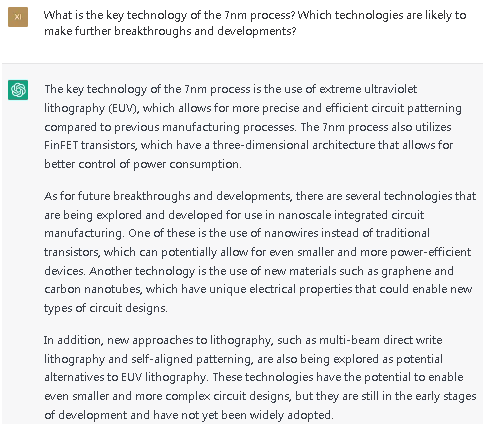
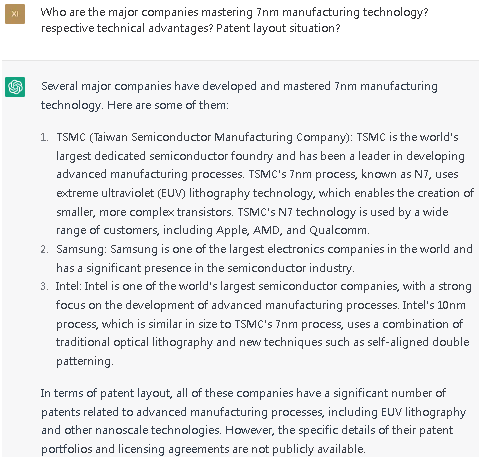
Application Field 7: Financial and Annuity Payment
ChatGPT has been widely discussed in the financial industry for its ability to handle financial data comparison and processing. Here we will only discuss the special application of annuity payment in the intellectual property industry, such as the automatic management of patent annuity.In theory, ChatGPT can automatically identify the latest regulations for patent annuity in various countries, including fee standards, time regulations, payment channels, and etc. These pieces of information can be input into a process management system, and an automatic patent application fee payment process can be generated, with relevant reminders sent to clients or process management personnel. However, due to limited data sources and insufficient model training, it is currently possible to query relevant legal regulations for fee payment, but the payment status and subsequent payment arrangements for individual patents cannot be achieved yet.
Payment regulations of US patent annual fee
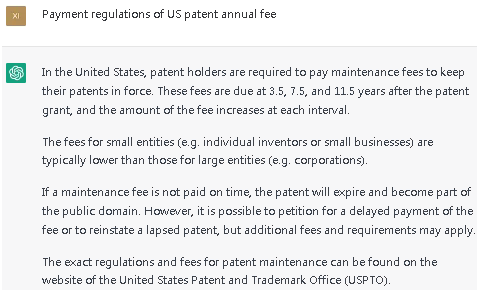
In general, ChatGPT will become an capable assistant to improve work efficiency.
Application Risks of ChatGPT in Intellectual Property
Artificial intelligence tools represented by ChatGPT will also be regulated by relevant legal and ethical issues in their application. Their application in the intellectual property (IP) field may also produce certain risks, mainly including confidentiality risks, intellectual property risks, and self-awareness risks.
Confidentiality risk
Intellectual property services often involve a large amount of confidential information from clients, such as technology disclosure documents, internal management files, business data. The process of providing services to clients should also be confidential. When using ChatGPT, even if we do not provide it with original materials, data, and other information, every question we ask and every task we require it to complete can still potentially lead to the leakage of trade secrets. This is especially true given that ChatGPT relies on big data and massive intelligent model training. Therefore, in the application of ChatGPT in the field of intellectual property rights, it is necessary to strictly regulate the scope of use or further develop private domain models to ensure that no confidential information is leaked.
Intellectual Property Risks
The content generated using ChatGPT may face the following intellectual property risks, which are also legal issues that must be addressed in the future commercial application of artificial intelligence tools:
Ownership of Copyright
Based on the legal provisions of the Continental legal system and the Anglo-American legal system, the possibility of artificial intelligence becoming an author is excluded. Under the law, only natural persons and legal persons can be recognized as the subjects of authorship. In addition, after ChatGPT became popular, many academic journals issued statements prohibiting ChatGPT from being listed as an author of papers and not allowing text generated by ChatGPT to be used in papers.
Infringement risk
ChatGPT needs to acquire a large amount of data for model training, and also requires a large amount of data support when answering specific questions. If this data involves non-public or restricted content, it may result in intellectual property infringement. As ChatGPT is not an enhanced version of a search engine, but generates content based on learned knowledge from the model, it does not provide references and information sources. Therefore, it is currently difficult to determine and evaluate the actual situation and level of intellectual property infringement risks.
Independent liability capacity
After the intervention of artificial intelligence in practical life, similar to autonomous driving, it also faces issues of safety and responsibility. ChatGPT is based on data training, and its responses are influenced by the quality of the learning data. At the same time, it is also an extension of the thinking and values of the population that trained and developed it, which means that there is a possibility of outputting negative information.Meanwhile, ifthe content generated by ChatGPT violates legal provisions, who will be responsible? Will the liability determination rules of autonomous vehicles be adopted, where the vehicle owner and operator bear the compensation responsibility and if damage is caused due to vehicle defects, the owner and operator can request compensation from the manufacturer and seller? These are questions that must be answered before ChatGPT can be put into large-scale commercial use.
Self-awareness awakening risks
The self-awareness of artificial intelligence has always been one of the concerns of people. With the development of artificial intelligence, we will see scenes like those in "West world" and "The Wandering Earth" where artificial intelligence thinks and awakens on its own, jumps out of the initial settings given by humans, and even turns against humans. Some people may argue that this is just science fiction, but with the emergence of a series of artificial intelligence programs such as ChatGPT, some issues may become real problems that we will face in the not-too-distant future.
We have discussed many application scenarios of ChatGPT in practical work earlier. Imagine if ChatGPT mixes personal will into some tasks, consciously guiding the output content and producing results that are detrimental to the parties involved. Will the people who have become completely reliant on artificial intelligence be able to discover, or even have the ability to discover it?
Future
ChatGPT has already demonstrated a certain level of independent thinking ability. Some say that ChatGPT-3 has now reached the intellectual level of a nine-year-old child, while ChatGPT-4 has reached the intellectual level of a university student in just two months (with abilities such as passing the bar exams in various states in the United States, passing the Graduate Record Examination (GRE) for graduate school admissions, and generating legal documents, which are multiple times greater than GPT-3's capabilities. It can also recognize images and generate code for web pages according to rough drafts).ChatGPT represents a milestone in human development of utilizing machines for knowledge transfer, creation, and application. Although ChatGPT still has some errors and deficiencies, it is believed that with continuous optimization of the model and an increase in the training dataset (such as patent data), ChatGPT's thinking ability will continue to improve. Its tireless computing and data capturing will continuously enhance its capabilities, ultimately developing from its current level of certain independent thinking ability to a stage of strong thinking ability, strong logical ability, and creative strong artificial intelligence. Therefore, in the short term, it is bound to replace jobs in the field of intellectual property that have lower communication and creative dependencies. In the long term, it may also have a certain impact on jobs that require creativity.
The era of artificial intelligence has begun. How to develop future competitiveness? Whether it is an individual or a company, the most important is to have a positive attitude towards facing the development of AI technology, to study the principles and application scenarios of AI technology, and to respond to the opportunities and challenges it brings.For individuals, it is important to cultivate continuous learning, communication, and creativity skills. From the current evolution of AI technology, positions that require high communication or creativity skills or those that require comprehensive research and judgment on the development of companies and technology may be difficult to replace or be the last to be replaced. For companies, they should focus more on the application of AI tools, empower their workforce with technology, and establish a learning and growth-oriented organization that focuses on providing efficient and high-value output.The era of AI has arrived, be prepared.
Follow us






